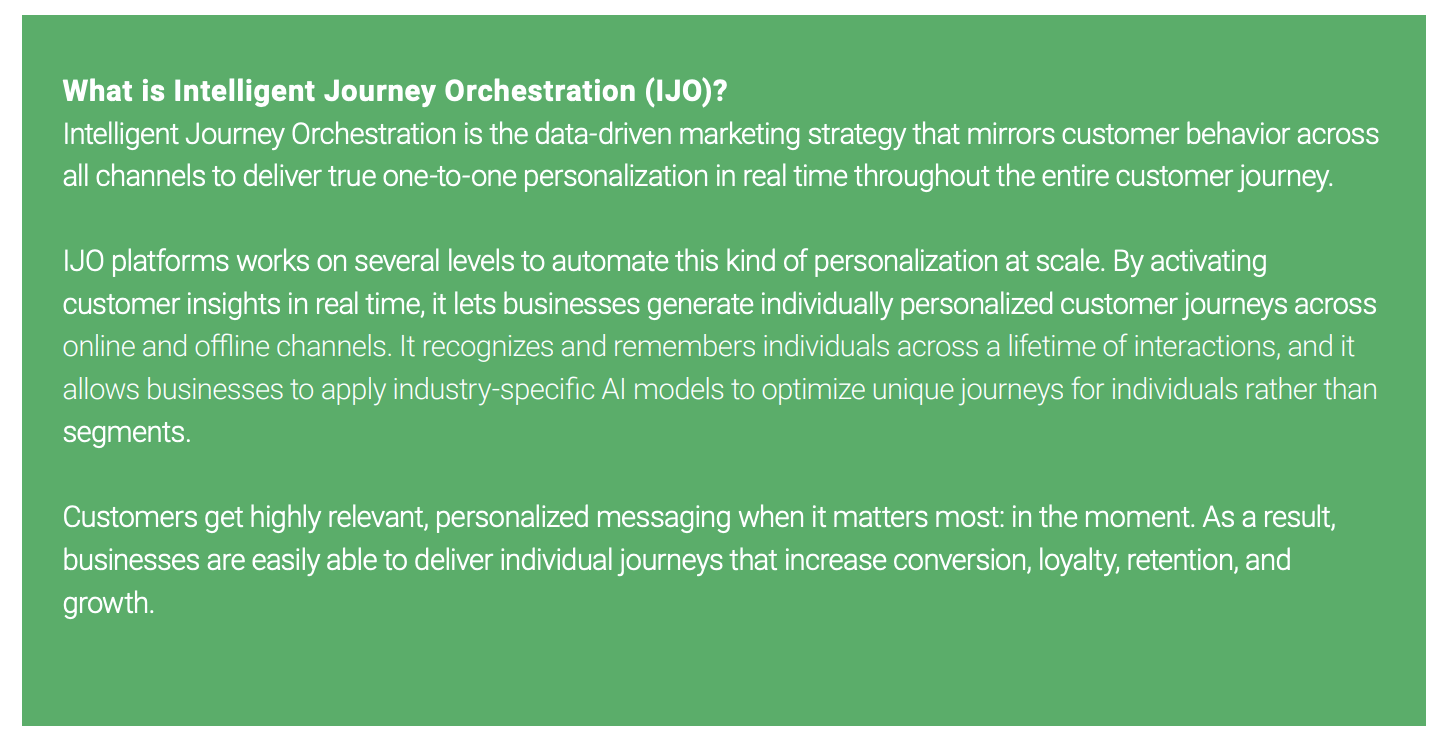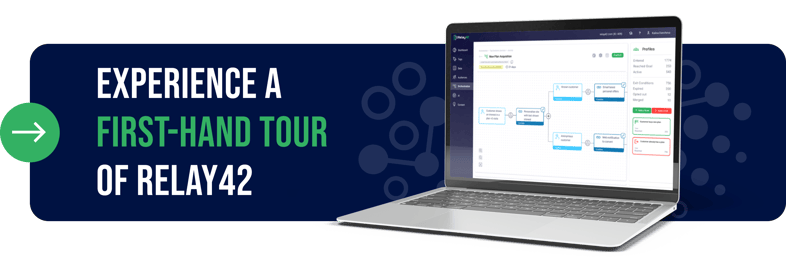How to Boost Your Travel Marketing Strategy with 1:1 Personalization
by Relay42 on 29.1.2021

CONTENTS
- What's on the horizon in the travel industry?
- It's time for smarter recommendations
- Connecting your business landscape
- How Intelligent Journey Orchestration works
- A global airline carrier smartens customer journeys and cross-channel bidding
- How Thomas Cook connected online and offline to personalize at scale
- What's next? Real results
WHAT'S ON THE HORIZON IN THE TRAVEL INDUSTRY?
The customer becomes their own travel agent
Using artificial intelligence and machine learning to search across thousands of trip options and create the perfect hyper-personalized offer is becoming less of a nice-to-have, and more a necessity.
Booking.com found out in its survey that 29% of global travelers say they are comfortable letting a computer plan an upcoming trip based on data from their previous travel history.
Bots, beacons and voice assistance
New channels are constantly coming into play, and in greater numbers. Some of them will be game changers, and the industry needs the flexibility to adapt, compete, and to test and learn together with their customers.
70% of requests to Google Assistant are expressed in natural language, meaning that people are getting more comfortable having conversations with computers (Google/Phocuswright).
Evolving online marketplaces
With the lines becoming increasingly blurred between direct booking, third-party meta-searchers and airlines, now is the time to centralize and synchronize customer relationships and bidding strategies.
The average traveler now spends time browsing an average of 38 websites before making a purchase (Expedia Group).
A continued ‘bleisure’ boom
It's become common for companies to bake trip incentives into employee benefit packages, and it's creating the need for smarter cross-channel data modeling to distinguish intent, make journeys more seamless, and personalize accordingly.
Seventy-four percent of North American business travelers are either planning or considering a bleisure trip in the next 6 months, compared to 87 percent in Asia and 68% in Europe (travelagentcentral.com, 2018).
IT'S TIME FOR SMARTER RECOMMENDATIONS
Below is an example of a typical customer journey. While well intended, you'll notice that it misses more than a few marks.

While it's clearly not an ideal journey, with just a few tweaks, it could have been an amazing getaway that turned Amy into a loyal return customer.
- If the OTA had a single source of truth for all of their data, with a single view of the customer, then it would have been clear from the start that Amy was booking a birthday getaway.
- If the OTA had the connections in place to stop retargeting once Amy booked a flight, and instead emailed her personalized ancillary offers, she could have enjoyed a great offer on a hotel, and the OTA would have scored a partner upsell.
- If the OTA's app had been connected to all of their other channels, they could have built a stronger relationship with Amy with relevant in-the-moment messaging.
The goal: Control connectivity, flexibility and actionable insights across customer journeys in order to personalize 1:1, at scale.
CONNECTING YOUR BUSINESS LANDSCAPE
So how can technology best help to deliver on your personalization goals?
A platform with Intelligent Journey Orchestration (IJO) helps centralize customers and uses channels as stepping stones for your customer’s journey.
IJO platforms connect all of your online and offline channels and devices, from event management systems and email to search, social media and your CRM. They then produce a single customer view that can cross-pollinate intelligence and create flexible actions across channels.
Avoid confusing consumer narratives
This means knowing your customers 100% with smart identity management and targeting them based on holistic insights in real-time across channels.
Zero lock-in and the flexibility to plug and play with future channels and technologies
Technology is the gateway to innovation for a connected world of travel. As applications, devices, interfaces and databases evolve, businesses need a compatible hub that won’t hinder progress but instead facilitate agile adoption. Then, teams can accurately test and learn what works.

HOW INTELLIGENT JOURNEY ORCHESTRATION WORKS
Here is an example of what your architectural framework could look like with all customer touchpoints and relevant business systems in dialogue.
The image below maps out two ways in which two travel sector leaders – a leading international airline and global booking agent Thomas Cook – arrived at solutions to personalize for their customers using Intelligent Journey Orchestration.

JOURNEY: GLOBAL AIRLINE CARRIER SMARTENS CUSTOMER JOURNEYS AND CROSS-CHANNEL BIDDING
This client is a heritage airline with a host of mission-critical technology that connects with the newest channels and draws actionable data from them to personalize messaging and avoid budget waste. Here is the process they used to integrate, innovate and personalize their marketing efforts.

1. Personalize and unify messaging across display and web
A customer lands on the airline’s own website. Based on their browsing behavior, they are served personalized display ads through connections between their website and external publishers. The result is a tailored ad created on the spot to reflect the individual's personal preferences.
With the help of their IJO platform, the airline then creates a rule to display a banner on their own channels that customizes itself based on the visitor in real time. This kind of hyper-personalization keeps the customer experience exciting and consistent, and ensures the airline's messaging evolves along with the user's preferences.
2. Better retargeting with CRM connectivity
Rather than chasing consumers around the internet with every offer, the airline can now retarget on display to manage frequency and match behavior. To achieve this, they use the IJO platform to connect their CRM with website behavior, and they further support the effort by exchanging booking data with partners in the same airline group.
This allows them to automate win-back emails and customize them specifically to a user’s preferences after a period of inactivity. This is supported by time-sensitive messaging which reflects flight availability on the creative side, accompanied by smart frequency capping: once a customer books a flight directly or through a trusted partner — targeting is stopped.
3. Tailored ancillary offers
After receiving a customized offer and following a resting consideration period, the customer books an airline ticket via the company’s own website. Via real-time updates, the website now reflects the customer journey in their ancillary product offers based on demographics and location. Examples include personalized car hire deals and offers for family-friendly hotels.
4. Smarter optimization across online and offline
By integrating CRM data with search engine remarketing, the airline can now predict value and fine-tune online bidding strategies on all keywords, so they know they're bidding on the right consumers at the right time. Using a broader omnichannel context, the airline can optimize media spend with profound results by better understanding a customer’s next-best-channel and bidding based on their predicted value.
5. Smoothing out revenue management
This also extends to directing media spend to the right routes and customers by filling inventory on less popular routes and avoiding over-advertisement of fuller flights. This can be optimized by taking input from pricing and revenue management and optimizing bidding strategies for paid search. From here, the airline uses machine-learning models to predict whether routes will sell out so they can drive the required amount of traffic to the right flights within a specified time-frame.

JOURNEY: HOW THOMAS COOK CONNECTED ONLINE AND OFFLINE TO PERSONALIZE AT SCALE
 The Relay42 platform allowed Thomas Cook to turn their creative experiments into actionable results. As traditional technologies don’t allow online marketers to use real-time data in their creative ads, Thomas Cook required a flexible platform that would integrate with their existing systems so they could get started with testing, learning and optimizing messaging.
The Relay42 platform allowed Thomas Cook to turn their creative experiments into actionable results. As traditional technologies don’t allow online marketers to use real-time data in their creative ads, Thomas Cook required a flexible platform that would integrate with their existing systems so they could get started with testing, learning and optimizing messaging.
1. Create custom product recommendations
Three designs were drafted to create visual recommendations that presented the products in different ways to highlight independent variables that Thomas Cook wanted to test – prioritizing various properties such as price, rating and availability.
2. Test and learn with behavioral algorithms
Thanks to the IJO platform, Thomas Cook could deploy personalized product recommendations by syncing with external eCommerce engines like Amazon.com. With predictive modeling, the platform found hidden relationships in visitor data and product interaction to determine which product to display to which visitor.
3. Recommendations on web and mobile
The platform's tag management capabilities then delivered the relevant recommendations, requiring no web development or IT involvement. The system delivered each visual design to the predetermined groups of users and compared these results to those of a control group.
4. Adding the missing link: online and call center
An invaluable connection between online channels and call center was then implemented. This means that any customers falling into the ‘ROPO’ (Research Online Purchase Offline) category are catered to: once recommendations have been delivered and a customer has booked their trip via phone, a trigger is delivered to stop remarketing and begin offering ancillary products across web and email.
WHAT’S NEXT? REAL RESULTS
The following outlines a series of benchmark results for travel clients who are using the Relay42 platform for cross-channel customer engagement, acquisition, retention and cost efficiency:

The paradox of technology and personalization
Ironically, technology is the missing component that marketers will need to deliver hyper-personalized content and service. The Relay42 platform for Intelligent Journey Orchestration could be what you're after if you're looking to:
- Create a panoramic landscape for your customers by connecting your existing business architecture with a data management solution.
- Set up basic rules to determine online behavior, and unify messaging across channels to produce actionable results.
- Push into the future by being a step ahead with personalization – understanding your customers’ behavior, from web all the way to call center.

You May Also Like
These Related Stories

What We Learned from 10 Years of Working in MarTech

How to Build a Connected Customer Journey in Banking


